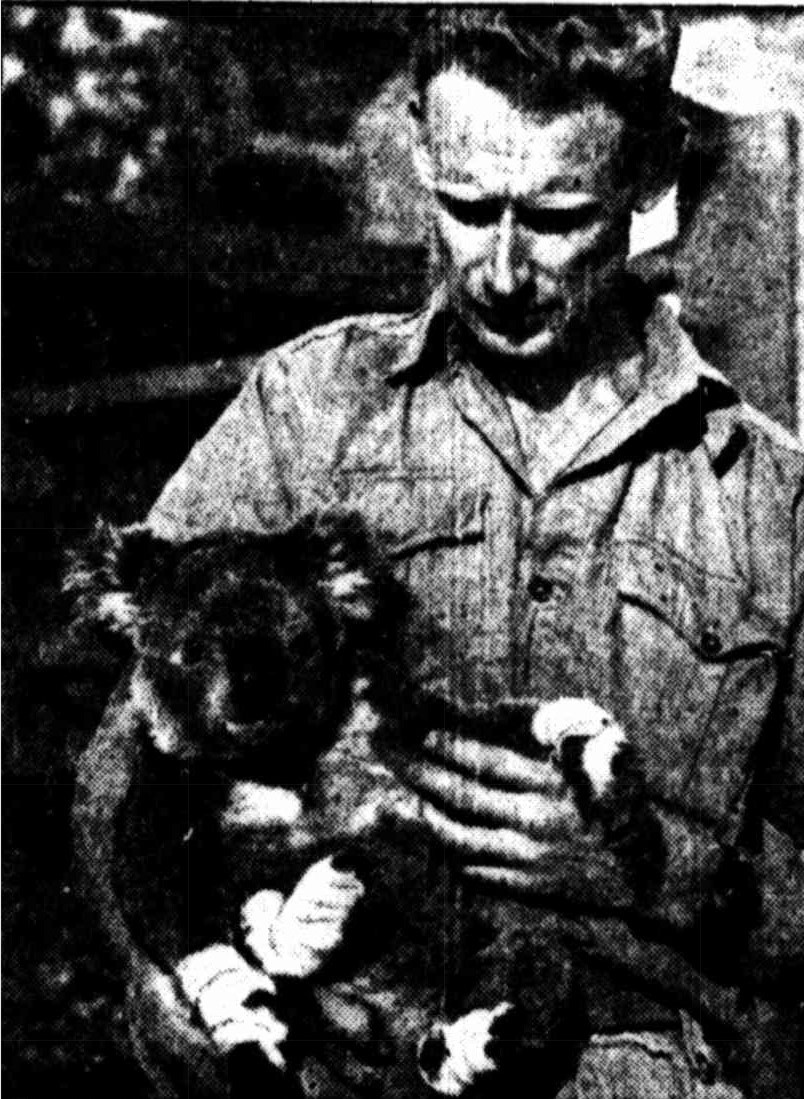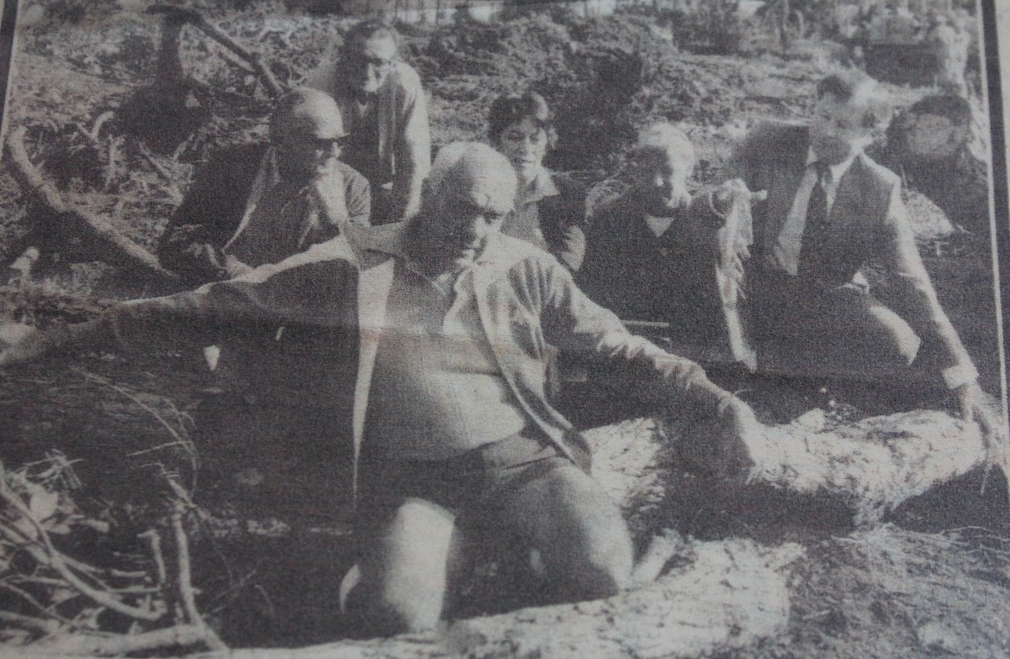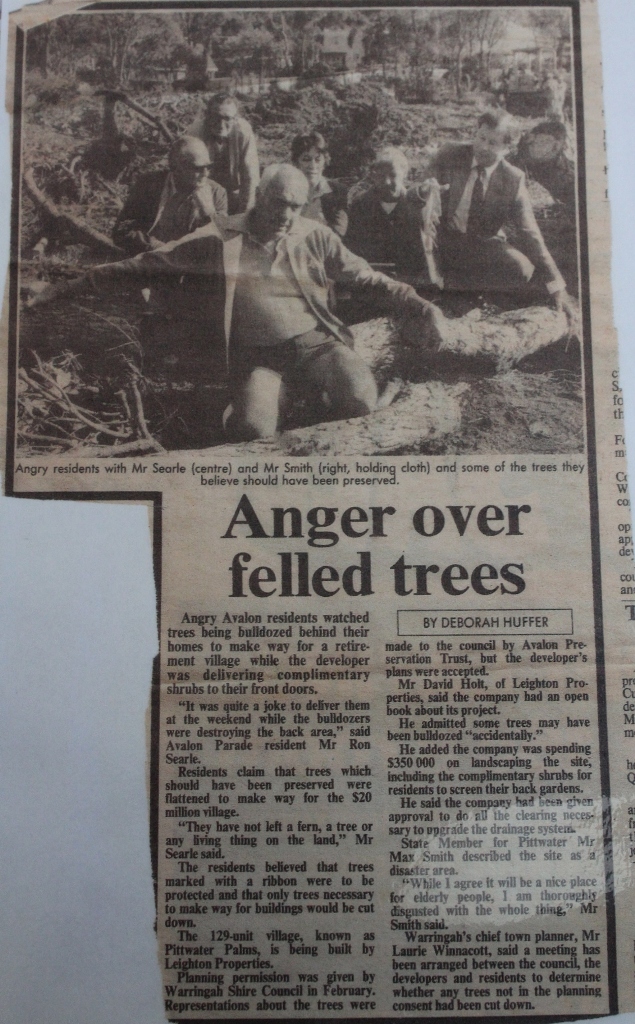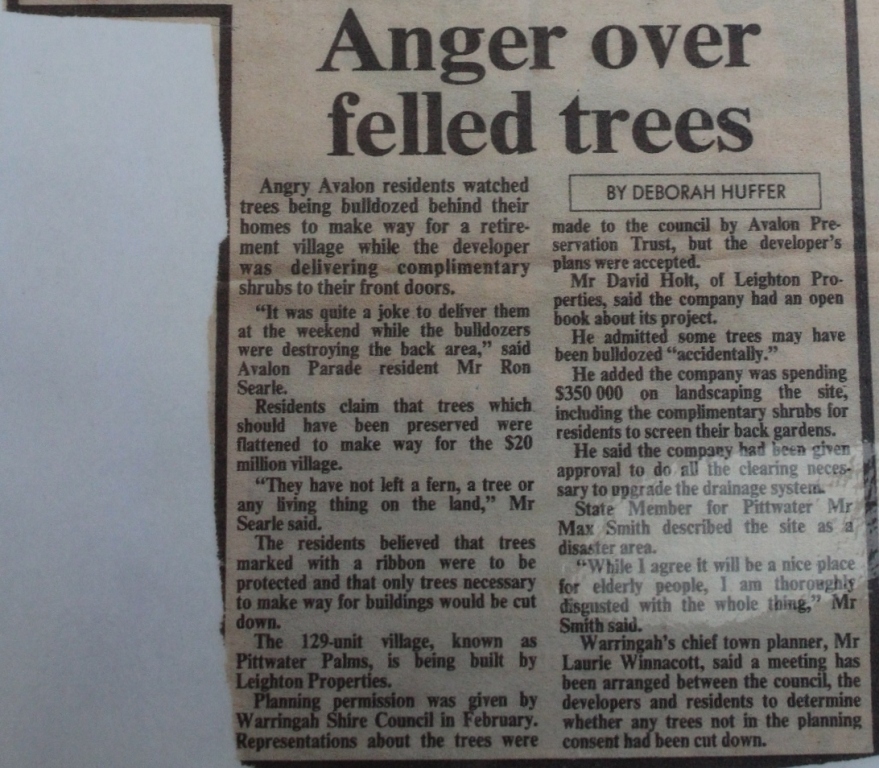November 24 - 30, 2019: Issue 430
Fires Last Straw For Koalas: Extinction Now Imminent Unless You Speak Up
All the efforts to save them, commencing with the Hallstrom Koala Sanctuary in Bayview in the 1940's, all those carried out during local bushfires, to those within living memory, were in vain - the worship of the dollar ruled, and still rules, the day.
A Bushfire Casualty

FIRE CASUALTY.- Paws bandaged, this koala was in safe hands at Taronga Park Zoo, on Saturday, after getting prompt attention for burns received in the bushfire at North Narrabeen. A Bushfire Casualty (1946, November 6). Queensland Times (Ipswich, Qld. : 1909 - 1954), p. 1 (DAILY). Retrieved from http://nla.gov.au/nla.news-article118381832
From the Avalon Preservation Trust ( now Avalon Preservation Association ) APT History:



Logging 'cruel' to animals
Forestry practices in Australia are killing off rare and endangered native animals, the RSPCA told a Federal inquiry. The executive officer of RSPCA Australia, Charles Wright, said yesterday that logging in native forests caused great suffering and the death of native wildlife.
Addressing the Resources Assessment Commission Inquiry into Australia's Forest and Timber Resources, Mr Wright said forestry practices had a dramatic effect on wildlife, including rare and endangered species. This included selective logging, clear-felling, plantation establishment, burning and pest control.
"A lot of logging practices are cruel," Mr Wright said. "Too many people are forgetting about the animals in the environment debate."
Mr Wright called for codes of practice to be established in forestry management.
"The timber industry docs provide some economic benefit to the nation but the real benefit of our unique wildlife is priceless and cannot be reduced to dollars and cents," he told the inquiry.
The RSPCA's submission to the commission says the greatest impact of forestry is on mammals dependent on native ecosystems. Species under threat include greater gliders in the native forests of eastern Australia and the landbeater's possum in the mountain ash forests of Victoria's Central Highlands.
Mr Wright said burning to clear forest land often killed native wildlife, and he called for improved practices, such as selective burning, rather than "the bushfire approach." Logging 'cruel' to animals (1990, June 15). The Canberra Times (ACT : 1926 - 1995), p. 5. Retrieved from http://nla.gov.au/nla.news-article120892539
Now that same process of mismanagement and 'greed first' is ensuring their extinction elsewhere. It is way past the time to ask WHO is still destroying our environment and WHY they are - those responsible are well known by now and why they are is still the age old robbing of the poor to make richer the already wealthy.
If the ABC News report of earlier this week regarding that those sent in to check on bee hives becoming traumatised after hearing the screams of wildlife in pain doesn't bring home the fact that our remnant forests are currently filled with animals screaming in pain - and everyone now needs to speak up - what will?
Many have never heard that sound of a koala crying in pain and shock - now you have.
Those that have been rescued and can be brought back to health, a constant nursing process that will take at least 12 months, will have no home to go to - to be released back into.
Just one of those koala rescue centres was spending 160 thousand dollars annually to run and care for the almost 300m hundred koalas it treats - and is run on donations. For koalas, outside of bushfires and Chlamydia, motor vehicle accidents and dog attacks are the most common cause of injuries sustained.
One of these koala rescue facilities has received over one million in donations from Joe Public during the course of these November 2019 bushfires. They intend spending that on the recovery of the 30 or so koalas that have been brought in as well as wildlife water stations, alike those we ran in a Sydney University article in June this year.
Their primary focus past that immediate work is to establish a wild koala breeding program. The koalas in the area Port Macquarie area are of national significance due to their genetic diversity. There are volunteers working at Taree (Koalas in Care) and Port Stephens (Port Stephens Koalas) too - and they too are significant.
Two Koala saviour organisations in this fire ground are determined to establish koala sanctuaries with food trees, one even resolving to buy the land and plant the trees, to own this place, so it cannot be taken away - although that will only last as long as a highway doesn't need to be run through it.
At the frontline those now tending the koalas, those still out in the firegrounds looking for wildlife, are all volunteers. Many of them have worked back to back shifts finding injured and burnt animals, tending their wounds.
While it's great the state government recently announced two grants in funding for the Foundation for National Parks, the reality is most of those doing the actual rescuing, rehabilitating, caring until they may be released, if there's somewhere to release them back to, all those medical supplies and carers pouches, all that veterinarian work done pro bono, comes from the pockets of the volunteers and their supporters, and has for decades.
Each year, in New South wales alone, over 100 thousand native animals are being rescued and saved. Millions more are being slaughtered - not being saved.
There are a few other things our state and federal governments could do, although that would involve a more genuinely caring approach and reversal of current 'policies and priorities'.
are only undertaken where necessary or beneficial for conservation of the species or as part of an approved offset arrangement [for a state significant development]
For those thinking there are forests aplenty yet available to kill off and turn into woodchips, the reality is the number of trees left can now be counted, with numerous reports detailing how policy has determined and facilitated more tree and habitat destruction, up to 100% of what's left in many places, in New South Wales.
Ask yourself - WHO is continuing to destroy what's left of our environment - and WHY? And most importantly - is it theirs to take and is there a better way?
We're not doing too well as the 'clever country', are we? Ditto 'NSW as the Number 1 state' for anything other than ...t.
Below run a few recent insights from a passionate campaigner for our wildlife and environment, who possibly wishes Australian governments were as enlightened as New Zealand government, where rivers and animals are recognised as sentient beings and they are not in a rush to cut down their very last tree.
Hopefully now, and well into the future, a few more will speak up and fend off the fast approaching silence a country devoid of all its original residents will mean.
You won't hear a koala crying or animals screaming in pain then - will you?
Fires Last Straw For Already Dying Koalas
November 18, 2019: By Sue Arnold
Koalas – along with Australia’s environment – are in dire straits, governed by politicians whose ignorance is literally costing the Earth.
The sun is blood red. Smoke fills the air like a heavy impenetrable fog covering trees with thick curtains of burned vegetation nanoparticles.
In the forests, the big trees are dying, their leaves curling up in a last gasp for water before they drop on the bone dry earth, creating a catastrophic loss of food and shelter for dependent animals. More fuel for more bushfires.
The sheer extent of the fires and their horrific intensity are the last straw for the koala populations in New South Wales, where well over 1,650,000 hectares have burnt with 75 fires still raging.
Key koala habitats have been lost. Coffs Harbour, Port Macquarie, Taree, Kempsey, Wardell, Clarence Valley, Lismore, Byron Bay have all suffered catastrophic bushfires together with Far North Coast forests — the heartlands of koalas.
Mainstream media has focused on an estimated 350 koalas lost to the fires in Port Macquarie. Yet the death toll is far more widespread and almost certainly spells widespread extinction for the koala, with few remaining healthy colonies surviving.
No mention has been made by any politicians that prior to the bushfires, forests were dying as a result of drought. Wildlife carers report that months before the fires broke out, koalas were coming into care dehydrated and suffering from malnutrition.
Carers at Koalas In Care Inc in Taree say koalas were already depleted as a result of no food and no water well before the inferno. Koalas rescued from the fires arriving at the shelter are very stressed.
A volunteer told IA:
Some are shaking from shock, we hydrate them, give them pain relief and food. It’s a massive effort. We’ve had several dozen come in, so many with burns. With so many areas still burning, we’re unable to search for any survivors.
Then there’s the issue of where to release the survivors? The leaves from relevant forest areas remaining are unable to provide the moisture and nutrients koalas need to survive.
In Lismore, at Friends of the Koala, a dozen or so koalas have come in from the fires. No one knows how many have died.
President Roz Irwin sums up the situation statewide:
“We were in a bad state before the fires, now this catastrophe. There’s nowhere we can release them that ensures their safety with the constant threat of more bushfires.”
Which raises the next question. New South Wales and Queensland koalas need to have their listing, under the Environment Protection and Biodiversity Conservation Act 1999 (EPBC Act), upgraded from "vulnerable" to "critically endangered" — a designation which would provide better protection than the current grossly inadequate situation.
But thanks to former Federal Minister for the Environment Greg Hunt, the likelihood of any recognition of the calamitous state of remaining populations is unlikely.
In 2015, Hunt signed off on the Common Assessment Method (CAM), yet another major step forward in the Coalition government’s significant efforts to ensure the extinction of Australia’s wildlife, including the koala.
All state governments agreed to the Intergovernmental memorandum of understanding – Agreement on a common assessment method for listing of threatened species and ecological communities (‘the Memorandum of Understanding’).
The Memorandum of Understanding supported the adoption of the Common Assessment Method (CAM) for listing threatened species, in order to reduce duplication of effort and achieve greater consistency in the classification of species across Australia.
Implementation of the CAM will lead to the creation of a single classification for species across Australia, reducing regulatory complexity for both the community and industry.
Using the common assessment method, participating jurisdictions will work together to ensure that species are assessed and, where warranted, listed in only one "nationally threatened" category.
The outcome is a "Single Operational List" of nationally threatened species.
There was no opportunity for public submissions, legal challenges or discussions as the CAM was agreed to behind closed doors.
Given that the regions and areas specific to wildlife species vary considerably with different ecological drivers, a national listing makes no scientific sense, further removing any attempt to protect a regional population.
Port Stephens' koalas provide a classic example. On l8 March 2015, an extensive scientific submission was provided to the NSW Scientific Committee in support of upgrading koalas in the Port Stephens Local Government Area (LGA) from "threatened" status to an "endangered" population under the NSW Threatened Species Conservation Act 1995.
Data collected in 2014 demonstrated a significant decline in the koala population since the early 2000s when it was estimated to be 300-500 animals. The submission estimated a 75 per cent reduction in koala habitat in the Port Stephens area since European settlement.
The Committee made a "Preliminary Determination" in support of the proposal to list the koalas as endangered:
“ ... in the opinion of the NSW Scientific Committee, the population is facing a very high risk of extinction in NSW in the near future.”
The determination was put on exhibition from 18 August to 13 October 2017.
One week later, on 25 August, the Threatened Species Conservation Act 1955 was repealed and replaced by the Biodiversity Conservation Act 2016. A new, renamed, "Scientific Threatened Species Committee" was appointed and the upgrading of Port Stephens's koalas was rejected.
The rejection letter indicated the Scientific Committee was required to consider the assessment criteria and procedures under a Common Assessment Method agreed to between the Commonwealth, states and territories, which provided grounds for the refusal.
Further advice indicated that a population is not eligible to be listed as endangered if the species is separately listed as "vulnerable" under the Federal Environment Protection & Biodiversity Act 1999 (EPBC Act).
Ironically, the plight of Port Stephens koalas had considerably worsened, with three major bushfires destroying critical habitat and incurring a significant loss of koalas. Australians for Animals Inc spent months with NSW Environmental Defenders Office attempting to mount a challenge the Port Stephens rejection but there are no legal provisions in the CAM which allow for any challenges.
There are no triggers under NSW, Queensland or Commonwealth environmental legislation to prevent extinction.
Only state governments can make submissions under CAM to upgrade ( or downgrade species).
Add to this deadly mix the Commonwealth Species Expert Assessment Plan (SEAP) developed by the Threatened Species Scientific Committee 'developed to encourage and support expert groups to undertake status review assessments of a particular taxon or group of species and submit a status report to the Committee for consideration that may result in recommendations to amend the (EPBC Act) list of threatened species'.
As IA has tracked the potential timeline of any hypothetical status review assessment, the end game is likely to take years. When the final assessment is put before the responsible environment minister to approve, it is his/her right to reject the assessment.
This is the short version of a web of complexities, all designed to ensure that species such as koalas on the verge of extinction will be history.
One of the tactics employed by state and federal governments to enshrine efforts to downgrade environmental legislation and protection is to create agencies, strategic assessments, bilateral agreements, guidelines and regulations way beyond the understanding of community organisations and conservation groups battling to save wildlife.
An urgent, independent population estimate of NSW koalas must be undertaken when the fire season ends. The results must be made public so that people can be made aware of any failure by the Berejiklian and Morrison governments to take urgent steps to upgrade the koala under the EPBC Act.
Australia’s environment is in dire straits, governed by politicians whose ignorance is literally costing the Earth.
You can donate to help injured and displaced koalas at Koalas in Care Inc HERE.
You can donate to help the NSW Rural Fire Service HERE.
You can follow Sue Arnold on Twitter @koalacrisis and Koala Crisis on Facebook here.
This Article was published first in the Independent Australian (IA) online news service - republished under a Creative Commons Licence.